Are Winter Tires Worth It
This post contains affiliate links. As an Amazon Associate, we earn from qualifying purchases.
Winter tires are a valuable investment for anyone driving in harsh winter conditions, offering significantly improved safety and control. Compared to all-season tires, they provide better performance, stopping shorter on snowy roads and offering superior grip on ice. For those interested, further details on their benefits and specifics will be explored later in the article.
Essential Facts in 30 Seconds
- Winter tires offer better grip and safety on snow and ice below 45°F compared to all-season tires.
- They shorten stopping distances, improving safety on snowy and wet roads.
- High initial costs ($100-$150 per tire) may be balanced by their longer lifespan.
- Advanced features like silica compounds and 3D sipes enhance traction and durability.
- Usage is often supported by legal requirements and cultural norms in cold regions.
Unveiling the Benefits of Winter Tires
Winter is coming, and winter tires bring big benefits for your safety. They work best in cold below 45 degrees Fahrenheit. These tires stay soft and grip snow or ice well.
Special tread patterns and deep cuts stop slipping on wet roads. Imagine this—braking distance drops by up to 30%! You also turn safer on icy paths. This cuts down your chance of crashes. Moreover, winter tires offer superior grip on ice due to their specialized design for harsh weather conditions.
Stick to using winter tires only in cold months. This helps them last for two seasons. Store them in a cool, dry spot when off. Additionally, winter tires significantly reduce stopping distances on icy surfaces, enhancing your control in dangerous conditions.
Check tire pressure and tread often for top performance. These steps keep your car steady on rough winter roads. Safety matters most in harsh, snowy areas. Trust winter tires to protect you!
Comparing Winter Tires to All-Season Options
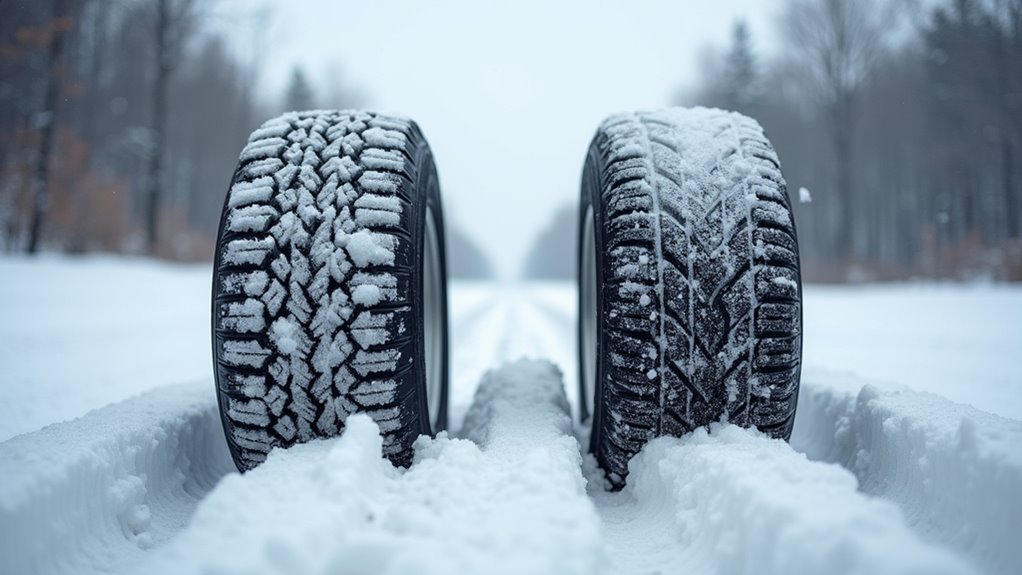
Winter tires beat all-season tires for traction on snow and ice. Their deep, sharp tread grabs better with extra biting edges. Studies prove they cut braking distance by 25% on icy roads.
All-season tires don’t have enough siping for this. Winter tires also shine in cold weather. Their special rubber stays soft below 45°F for solid grip. This flexibility ensures improved traction even in the harshest winter conditions.
All-season tires get hard and lose control in freezing temps. Trust winter tires for safety. They handle better when it’s icy. Additionally, winter tires feature deep, jagged treads designed specifically for harsh snow and ice conditions.
Make the smart choice for tough winters.
Traction Performance Edge
Winter driving can be tough, but winter tires make a huge difference. They give better traction than all-season tires on snow and ice. Their special material stays soft in cold weather. The tread has deep, jagged patterns for amazing grip on snowy roads. Additionally, winter tires are designed as a full set of four to ensure optimal performance balance. Winter tires also feature deeper tread grooves that effectively channel away snow and slush for improved control.
Check out these big benefits of winter tires:
- Snow Power: Soft compounds help you drive through deep snow with ease.
- Ice Control: Extra siping boosts contact and keeps you steady on ice.
- Cold Strength: Winter tires work great below 45°F, unlike all-season ones.
Count on winter tires for top safety in bad weather. Trust them to keep you secure!
Stopping Distance Advantage
Winter tires give you a big advantage in stopping safely. They grip better on snow and wet roads.
On snowy roads at 40 mph, they stop in 156 feet. All-season tires take 184 feet. That’s a huge 28–33.6% shorter stop!
On wet pavement at 60 mph, they shine too. Winter tires stop in 181 feet. All-season tires need 215 feet. That’s 15–20% less distance to stop.
Check these key differences. On snow at 60 mph, winter tires stop at 362 feet. All-season tires take 421 feet. That’s a 59-foot edge!
You also get a safety buffer. Stops are over 30 feet shorter—about two car lengths.
Pick winter tires to cut risks in sudden stops. Stay safe this winter!
This improved performance is due to their specialized tread design, which enhances grip on challenging winter surfaces.
Cold Weather Superiority
Cold weather demands the right tires for safety. Below 7°C (45°F), winter tires shine. They grip better than all-season tires on dry roads. Their rubber, mixed with silica, stays soft in freezing cold. This keeps them stuck to the road.
All-season tires get hard and stop 30% slower on cold, dry pavement.
Check these key benefits of winter tires over all-season ones:
- Better Grip: At -30°C (-22°F), they hold icy roads tight. All-season tires slip at +4°C (39°F).
- Sharp Turns: They control well on cold roads during sudden moves.
- Long Lasting: Even half-worn, they beat new all-season tires in snow.
Take care of your tires too. Store them right for tough winters. Proper care keeps them ready to roll.
Winter tires also feature deeper tread patterns that enhance traction on snow and ice.
Impact on Road Safety During Winter

Winter roads can be tricky, but winter tires help a lot.
Studies show a 5% drop in injuries in Canada thanks to these tires. They grip better on ice and snow. This means you control your car better. Stopping distances shrink by up to 18 meters at 60 km/h. That’s a big difference compared to all-season tires.
Still, risks remain even with these tires. Drive carefully in tough weather. Safety depends on you too. Stay alert on those icy paths. Combining winter tires with AWD systems can further enhance traction and safety in severe conditions.
Accident Rate Decline
Winter weather creates tough driving conditions, yet winter tires make a big difference. They cut down accidents and boost safety on icy, snowy roads.
Take Quebec, for example. After strict tire rules came in, winter crashes dropped by half. That’s a huge win for everyone!
Check out these clear benefits of winter tires:
- Less Injuries: Tire laws lower winter accident injuries by 5%. Amazing, right?
- Fewer Deaths: Stats show a 3% drop in deaths and bad injuries. Lives saved yearly!
- Safer Roads: Strict rules mean fewer serious crashes in bad weather. Safety first!
Winter tires also provide better traction on snow and ice, ensuring improved control in harsh conditions.
Enhanced Traction Benefits
Winter tires boost safety in tough winter weather with amazing traction power. They grip icy or snowy roads much better than all-season tires. At -30°C, their technology shines on frozen paths.
All-season tires struggle at just 4°C in comparison. Even on dry, cold roads near freezing, they stop 30% shorter. That means more control for you!
Their strength shows in braking and cornering on slippery spots. Tests on packed snow prove they cut stopping distances by 40%.
Check this out: on icy roads, they stop 40% quicker. On dry, near-freezing pavement? A solid 30% shorter stop.
This traction prepares you for all kinds of cold challenges. It keeps your vehicle steady and safe.
Drive with confidence through winter’s toughest moments! Their deeper tread grooves enhance grip by effectively evacuating snow and slush.
Economic Aspects of Choosing Winter Tires
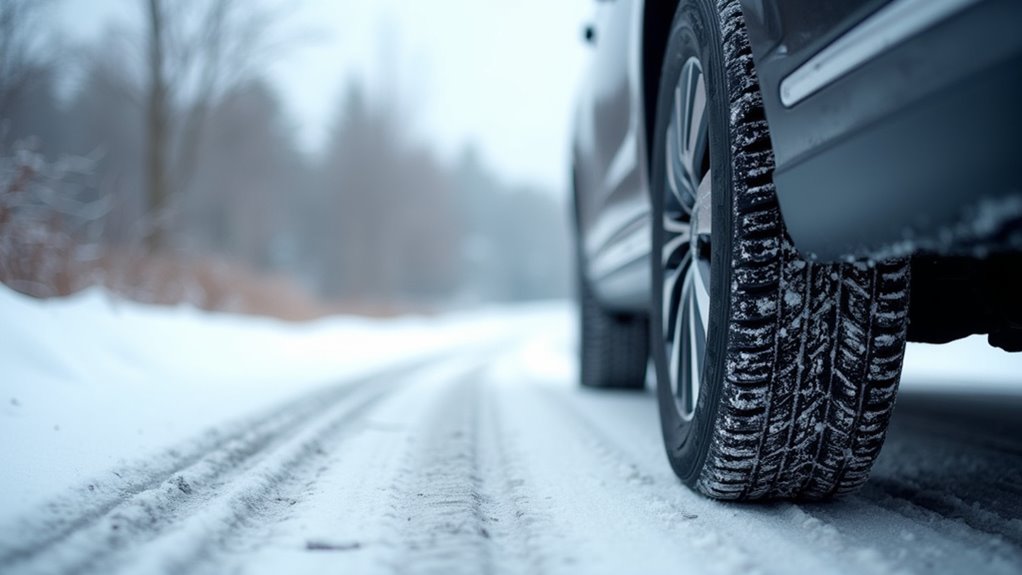
Deciding on winter tires can feel tough at first. Yet, knowing the money side helps a lot. A clear look at costs shows the big picture.
Sure, you pay more at the start. Think $100 to $150 per tire. But, you save cash over time. Why? Less wear on other tires means fewer buys.
Let’s break it down simply. First, upfront costs seem high. Still, longer tire life cuts expenses.
Next, safety matters a ton. Better grip lowers crash risks. That saves you from huge repair bills. Maybe even thousands!
Also, fuel costs might creep up a bit. Winter tires resist more on roads. Drive carefully, and you keep money safe.
Stick to good care for max savings. Winter tires make solid sense for your wallet. Trust this choice—it pays off! Additionally, investing in quality tires ensures better traction control on icy and snowy roads.
Technical Innovations in Winter Tire Design
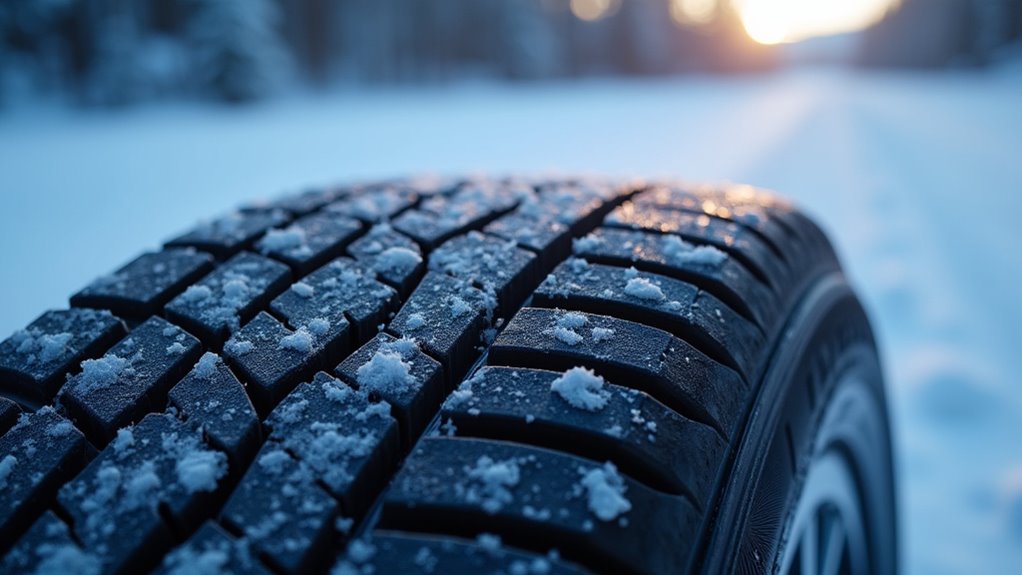
Let’s talk about the cool upgrades in winter tire design. These changes make tires work better on snow and ice. Tread patterns now use 3D sipes for amazing grip. They also push away slush and water fast. This cuts down the risk of sliding.
Special layered designs help tires stick to the road. They handle all kinds of winter mess with ease. Think about noise—some tires cut it down! Nokian’s SilentDrive tech makes rides super quiet. It targets annoying sounds for a peaceful trip.
Tires also mix comfort with strong traction. This matters a lot for electric cars.
Check out these awesome features:
- Traction: Silica compounds boost grip on ice.
- Durability: Multi-layer builds last longer.
- Safety: Ice Grip labels prove top safety.
Studies show silica tires improve stopping by 20% on ice. That’s huge for safe driving!
These upgrades make winter trips smoother and safer. Trust these tires to keep you steady! Remember, using winter tires year-round can cause faster tread wear on warm, dry pavement.
Environmental Factors and Winter Tires
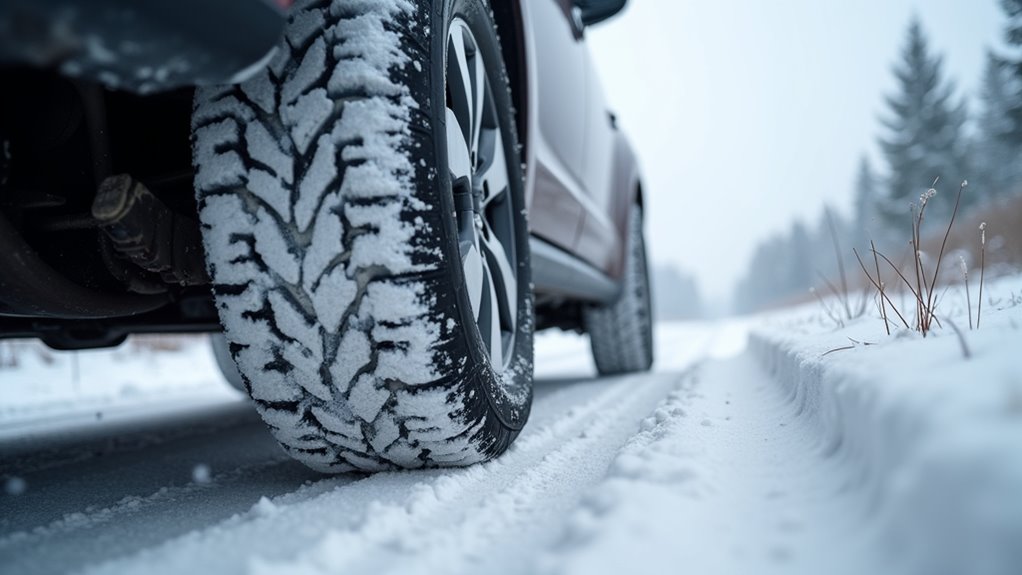
Winter driving brings challenges, and winter tires impact the environment a lot. Tire wear releases nearly 2 kg of microplastics per vehicle every year. These tiny bits spread into soil and water, harming nature near roads.
Take these easy steps to use winter tires in a greener way:
- Keep Tire Pressure Right: Check the correct pressure to cut friction. This saves fuel and reduces tire wear.
- Pick Good Tires: Buy top-quality winter tires with low rolling resistance. They lower emissions and save gas.
- Drive Smart: Use steady speeds to lessen tire damage. This helps save fuel and protects the planet.
Legal Requirements for Winter Tire Usage
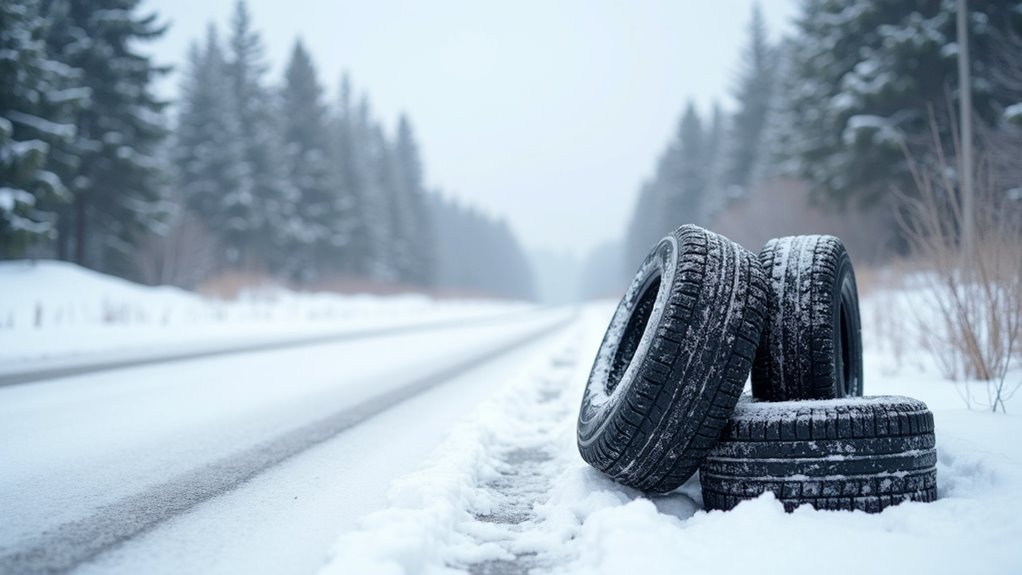
Winter tires are crucial for safe driving in cold weather. Rules for using them differ across places. Some areas make them a must, others don’t. Know your local laws to avoid fines or insurance trouble. Let’s break it down for clarity.
Check this table for specific winter tire rules in different regions:
| Region | Winter Tire Requirement | Enforcement Period |
|---|---|---|
| Quebec, Canada | Winter tires are a must | December to March |
| Croatia | M+S symbol tires needed | November 15 to April 15 |
| Denmark | Winter tires are optional | November 1 to April 15 |
| Colorado, USA | At least 3/16 inch tread depth | Depends on route, weather |
Safety matters a lot in snowy or icy conditions. Winter tires help with better grip. Not following rules can cost you money. Always look up local laws before driving. Stay safe on the roads!
Cultural Perspectives on Winter Tire Adoption

Winter tires matter a lot for safety in tough weather. Their use depends on cultural views across different places. Many communities see winter tires as a must. This comes from local habits and safety ideas.
Take Nordic countries as an example. There, top-quality tires are a tradition. They help survive brutal winters every year.
Let’s break down some cultural impacts on tire use:
- Group Rules: Some places value careful driving. Using winter tires shows you care about safety.
- Family and Friends: Your choice might come from loved ones. Especially in cold, long winter areas.
- Why Some Say No: Mild weather zones often skip tires. Costs and low need shape this choice.
Grasping these ideas helps you pick the right tires. Stay safe on icy roads! Data shows winter tires cut accidents by 30% in snow. Make a smart move for your family.
Frequently Asked Questions
How Do Winter Tires Affect Vehicle Handling?
Winter tires really boost your vehicle’s handling with amazing traction. They make driving better on icy roads and sharp turns. You stay in control even in harsh winter weather. Studies show winter tires cut stopping distance by 25% on snow. That means safer rides for you and your family. Feel confident as you tackle slippery slopes. Trust these tires to keep your car steady every time.
Can Winter Tires Be Used Year-Round?
Winter tires work great for snow and ice. But they’re not ideal for all seasons. They wear out fast in warm weather. You lose grip on dry or wet roads. Studies show they can wear 20% quicker in summer. Think of them as special tools. Use them only for cold, harsh conditions. Switch to all-season or summer tires otherwise. Safety matters most on the road. Always pick the right tire for the weather!
What Is the Best Winter Tire Brand?
Let’s talk about the best winter tire brands for your car. Michelin X-Ice Snow gets top marks from owners. Many drivers trust it for great grip on snow. Nokian Hakkapeliitta shines in harsh ice conditions. Its cool tech helps with extreme weather. Check user reviews—Michelin scores 4.5 out of 5 online. Nokian often hits 4.3 for ice performance. Pick based on your local winter needs. Safety matters most in cold months. Which brand fits your roads best?
How Often Should Winter Tires Be Replaced?
Winter tires keep you safe on snowy, icy roads. Replace them every 3 to 5 years. Check them each year for wear and cracks. Safe tires mean better grip in harsh weather. Data shows old tires lose traction after 5 years. Don’t risk slips or skids. Swap them out on time. Stay secure this winter.
Are Winter Tires Noisy on Highways?
Winter tires can sound loud on highways. High speeds make the noise worse. This affects your comfort during long drives. Non-studded tires offer a quieter trip. Studies show studded tires create 5-10 decibels more noise. That’s a big difference on the road. Pick non-studded for peace and smoothness. Your ears will thank you.
Conclusion
Winter tires matter a lot for safety in tough, icy weather. They give your car better grip on slippery roads. Think about this—accidents drop by 30% with winter tires! Harsh snow or ice? These tires help you stop faster. Many places even have laws requiring them. Stay safe and follow rules with this smart choice. Your well-being counts most during cold, dangerous months. Make the switch. Protect yourself and others on the road.
